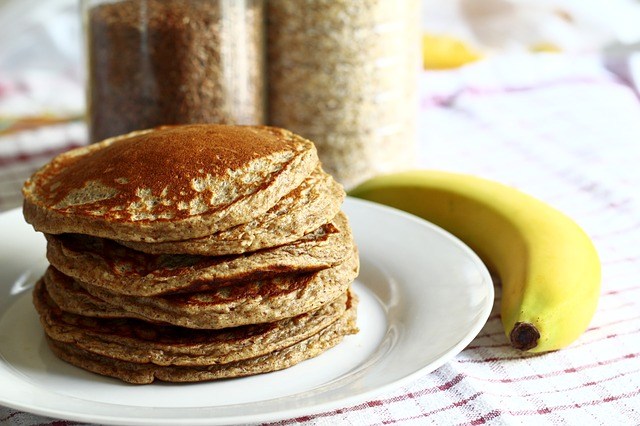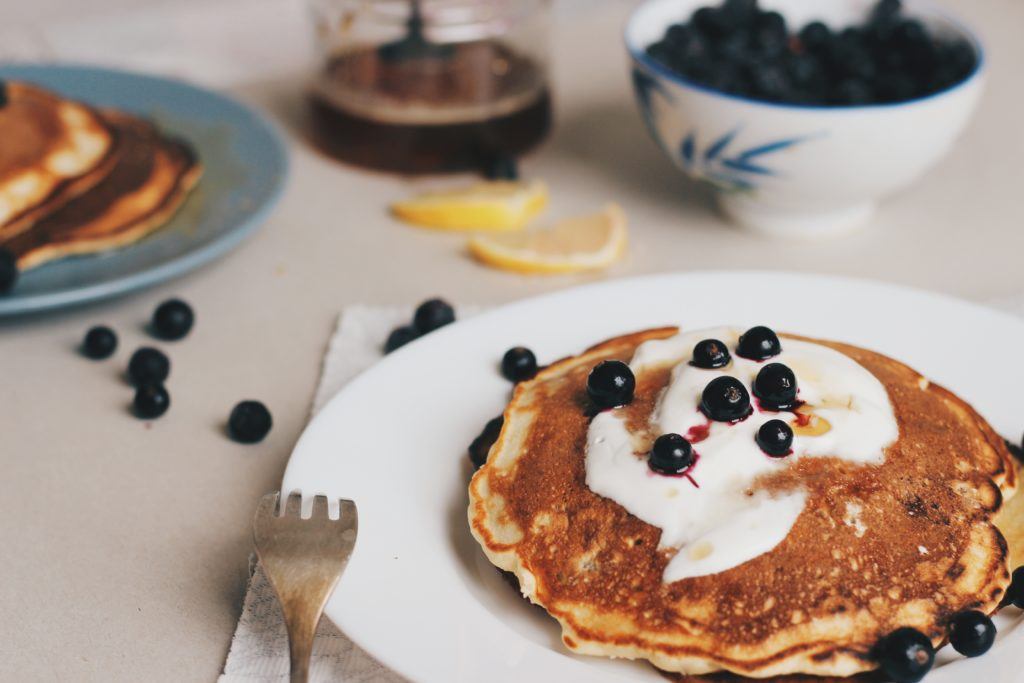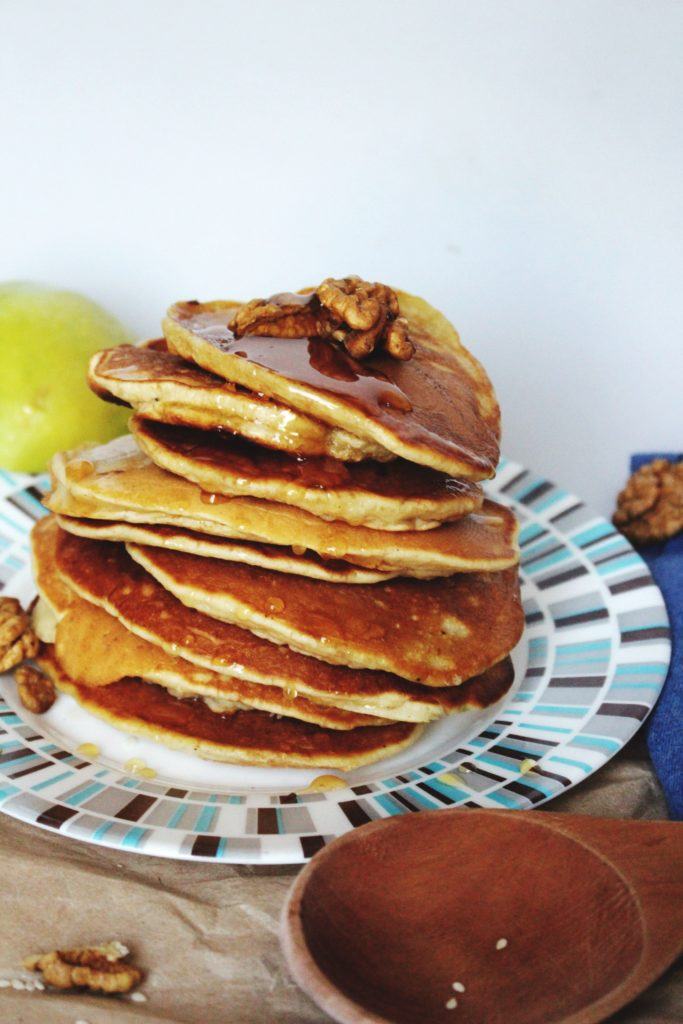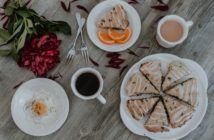Pancakes are among one of the oldest prepared foods, and today, people all over the world enjoy it in many, many different forms.
The French enjoy a good crepe, which is a thinner, crispier version of its American cousin that is folded over a sweet or savory filling, while the Japanese enjoy a more savory version known as okonomiyaki, which is a pancake comprised mostly of different kinds of vegetables.
Still, if you want a light, fluffy treat for breakfast, the American version is the way to go. This type of pancake is also very easy to make from scratch. Most of the ingredients can already be found right in your kitchen!
This basic pancake recipe is easily adjustable, so feel free to experiment with it to create homemade pancakes that will suit your unique tastes.
Below are also a few tips and tricks for creating delicious, fluffy pancakes that may even best Martha Stewart’s pancakes!
Contents
Easy Pancake Recipe
Ingredients
Dry Ingredients
- 1 1/2 cup of all-purpose flour.
- 2 tablespoons of sugar.
- 1 tablespoon of baking powder.
- 3/4 teaspoon of kosher salt (or 1/2 teaspoon of fine sea salt or table salt, if you prefer).
Wet Ingredients
- 1 1/4 cup of milk.
- 1 egg.
- 4 tablespoons of melted butter for the batter.
- Butter to coat your skillet or griddle.
- 1 teaspoon of vanilla extract.
How to Make Pancakes from Scratch
Keep in mind that this recipe is just a base to make plain, fluffy pancakes. Feel free to add in your own extra goodies like chocolate chips, nuts, or berries – or swap out a few ingredients with those you like even more!
This recipe takes about 30 minutes to complete, with 10 minutes for the prep work and 20 minutes for the overall cooking stage.
It makes four servings of two pancakes each.
- Whisk all the dry ingredients (your flour, sugar, baking powder, and salt) together in a medium bowl until they are thoroughly mixed.
- Heat up your milk in the microwave or in a pan until it becomes lukewarm. Do not let it boil or get too hot!
- Whisk all the wet ingredients (your lukewarm milk, your egg, the melted butter, and your vanilla extract) together in a separate medium-sized bowl from your dry ingredients. Melted butter mixes much easier with the lukewarm milk, as cold milk would form small lumps in the mixture.
- Whether you choose to use a large skillet or a griddle, always preheat them on medium heat. You will know if the skillet or griddle is hot enough when you pour a little water onto it and the water dances around on the surface before eventually evaporating.
- Clear out the center of your dry ingredient mixture bowl to pour in your wet ingredient mixture. Use a fork to stir them together until you do not see any clumps of flour.
- Lightly brush your skillet or griddle with butter (however much you need to coat the surface), and then use a measuring cup to help you spoon the batter onto it. Spread the batter into about a four-inch circle for each pancake you plan to make.
- You will know it is time to flip the pancake when the edges look dry, and bubbles appear and pop on the surface of the pancakes. This process should take about two minutes. Once you have flipped your pancakes, let it cook for another minute or two until it is a light brown or cooked in the middle.
- Serve with maple syrup, fruits, or nuts and enjoy!
Notes on Substituting Pancake Ingredients
Any of the ingredients called for in the pancake recipe above can be substituted to create different textures or flavors.
Flour
You can easily substitute the all-purpose flour with whole wheat flour instead.
All-purpose flour is what makes your pancakes light, but, if you want a denser, heavier pancake, you can replace some of that all-purpose flour with whole wheat flour, which is much thicker.
However, be sure to substitute no more than a quarter of the all-purpose flour the pancake recipe calls for, otherwise you risk ruining the fluffy texture you want your pancake to be.
Keep in mind that these types of flour are not interchangeable with one another, as they create different textures in your baked goods.
Sugar
Typically, granulated sugar is the type called for in pancake recipes, but you may also choose to substitute that with brown sugar, honey, or maple syrup.
Brown sugar will make your pancakes moister, while honey or maple syrup will lend a different taste to your pancakes.
Honey itself can come in numerous different flavors, so feel free to experiment with each one to find which you like the best. Orange blossom honey, for instance, will give your pancakes a citrusy, floral taste, while buckwheat-flavored honey is more molasses-like in nature.
However, honey can be a difficult substance to use as a pancake ingredient substitution and in baking in general.
Keep in mind that substituting honey for sugar is not an equivalent exchange. Because honey can sometimes taste even sweeter than sugar, depending on its flavor, it is best to use less than the amount of sugar the pancake recipe originally calls for.
A good rule of thumb is that for every cup of sugar in the recipe, substitute only 1/2 to 2/3 cups of honey.
Because honey is made up of about 20 percent water, you will also need to reduce the amount of liquid you use with your pancakes. For every one cup of honey that you use, subtract 1/4 cup of all other liquids the recipe calls for.
Honey also burns quicker than granulated sugar, so be sure to lower the heat on your stove by about 25 degrees or so, and keep a sharp eye out when making your pancakes.
Maple syrup can be equally as volatile. When you substitute maple syrup for sugar, be sure you decrease the amount of liquid the recipe calls for by about 3 tablespoons. For every tablespoon the recipe calls for, use 3/4 a tablespoon of maple syrup instead.
If you want to use a sugar substitute, such as agave nectar or Stevia, be sure you keep in mind that these are also not equivalent exchanges.
A good rule to remember, when you want to use agave nectar instead of sugar, is to decrease all liquids you use by about 1/4 cup to counterbalance the amount of liquid already in the nectar.
You must also remember that, like honey and maple syrup, agave nectar is sweeter than sugar, so, again, it is best to use less. For every tablespoon of sugar the recipe calls for, use 3/4 a tablespoon instead.
Stevia is even trickier than honey, maple syrup, or agave nectar. You will need to use much less Stevia than sugar in your pancakes, due to its extremely sweet flavor.
Simply add in applesauce, apple butter, or yogurt to fill up the rest of the sugar content the recipe calls for if you are worried about the bulk of your pancakes.
For every tablespoon of sugar the recipe calls for, use only 1/8 teaspoon instead.
Milk
Milk with any percentage of fat will suffice, whether it be whole milk, two percent, or fat free. You may also choose to use almond milk or coconut milk too.
Be mindful of the type of milk (dairy versus non-dairy) that you choose to use, as the flavor of your pancakes will differ depending on this choice.

Butter
Butter or stick margarine tends to work best for pancake recipes, but you may also substitute in coconut oil as a tasty alternative.
Vanilla Extract
Vanilla extract adds a unique sweetness to pancakes, but you may also use different types of baking extracts if you like.
Depending on the flavor of the extract, your pancakes may also end up with a different flavor, too.
Add-Ins
You can also add in a number of other sweet ingredients to make these homemade pancakes your own!
Small berries like blueberries or blackberries, chopped nuts, or chocolate chips should be mixed into the batter before you cook your pancakes. You may also choose to mash some fruits and mix that into the batter as well.
You can lay a few thin strawberry or banana slices onto your wet pancake batter after you have already added it to the hot skillet or griddle. The basic rule for flipping listed in the recipe above still applies here.
You can also add lemon zest or other spices like cinnamon, nutmeg, or allspice to your pancake batter to give your final dish more of a kick.
You may also choose to add a few spoonfuls of flax seed, oats, or reduce the amount of sugar you use to create a heartier pancake.
You can also top your homemade pancakes with any number of sweet things.
Besides the more obvious butter and maple syrup combo, you can also sprinkle confectioners’ sugar or small fruit slices on top, or drizzle honey, preserves, jam, whipped cream, or chocolate syrup on top of (or in between) the stack!
Other Tips for Cooking Pancakes
If you want fluffy pancakes, it is important that you do not over-mix your batter! Over-mixing will result in heavy, flat pancakes rather than light, fluffy ones.
This is why you should mix the dry ingredients and wet ones separately from one another at the start.
When you do mix these two together, however, be sure you mix ONLY until you do not see large clumps of flour in the batter. Smaller lumps are fine and will not ruin your pancakes’ overall texture or taste.
Here’s a video showing how to make cinnamon roll pancakes from scratch.
What’s your favorite pancake recipe?






